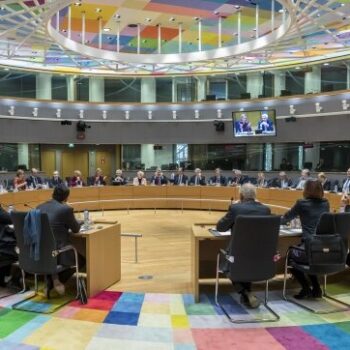Two years after Copenhagen, Europe finds itself central to shaping the direction of the global climate change regime again.
By the Durban conference in December the EU needs to decide whether – and how – it will sign-up to a second commitment period for the Kyoto Protocol. But Europe is characteristically dithering over the choices involved, and is therefore failing to shape the global political and policy environment around this decision.
A comprehensive binding regime which would deliver a 2°C future is not on the table at Durban. There is currently no political space for such an outcome. Given that most major emitters will see leadership transitions in 2012, the soonest any real debate on higher ambition can happen is from 2013. The first Kyoto commitment period finishes in 2012 so Europe needs to make a decision on the future of Kyoto outside the context of an overarching “global deal”. Europe must move on from the strategic offers it defined in advance of Copenhagen to an approach that reflects today’s realities.
Signing up to a second commitment period requires Europe to do nothing more in terms of additional emission reductions. Europe has already committed to delivering domestic emissions reduction to 2020, well beyond the period of the second commitment. As emissions have grown more slowly and oil prices are much higher than expected before Copenhagen, the EU also has good economic reasons for increasing its domestic climate action unilaterally. This decision should be delinked from the international negotiations.
In Europe’s interest
In this context, the main argument for not agreeing to a second commitment period is that Europe will look stupid if it commits without other developed countries such as Canada and Japan, despite the fact that Australia, New Zealand and perhaps even Russia are likely to follow Europe’s lead. If Europe does decide against a new Kyoto commitment it will show again that the politics of emotion have trumped a clear-eyed view of what it takes to deliver Europe’s long term political, economic and security interests.
Because asking whether others will act is the wrong question. The real question is whether signing-up to some form of second Kyoto commitment period will support Europe’s fundamental interests.
Firstly the counterfactual. If Europe leaves the Kyoto Protocol it will be destroying one of its major diplomatic achievements of the past two decades. A treaty which it backed by consensus in the face of the Bush administration’s withdrawal in 2000. A treaty it has spent at least €40 billion of European energy consumers’ money to support by purchasing international carbon credits. By leaving the EU will earn the opprobrium of the developing world for the final climate betrayal. Meanwhile US climate sceptics and OPEC countries will sit in quiet satisfaction at the irony of seeing Europe take the blame for destroying the only legally binding set of global climate rules.
But the real reason why Europe must stick with Kyoto is not because we will look weak, but because it is in our fundamental interest as a region. Europe needs Kyoto because it defines the type of climate regime that can actually deliver European security. Europe needs Kyoto because it provides the core around which we can build a coalition of countries to support an effective 2°C climate regime. Europe needs Kyoto because otherwise it walks naked into the negotiating chamber, having thrown away its best levers to bring the US and China into line.
Kyoto contains the critical architecture needed to for an effective global climate regime. Kyoto contains all the necessary elements for monitoring, compliance, finance, technical cooperation and economic efficiency. There is no magic institutional structure waiting to be discovered that isn’t already contained inside – or is compatible with – a reformed version of the Kyoto Protocol. The Kyoto architecture took years to negotiate, refine and ratify. There is no time left to start from scratch again. Whatever the often shrill rhetoric from across the Atlantic, the problem many countries have with Kyoto is not because it is flawed, but because it holds them to account in delivering real greenhouse gas emissions reductions.
The only way to constrain global temperatures to around 2°C is through the type of “top down“ structure agreed at Kyoto, where governments negotiate against an overall ambition of emissions reductions and apportion effort to meet a global goal. The alternative – backed by the US, Saudi Arabia and others – is a “bottom-up” agreement where countries decide how much they want to reduce emissions individually, and we all have to live with the climate instability delivered by these uncoordinated decisions.
Copenhagen showed us the limits of bottom-up action. Even an optimistic reading of the Copenhagen pledges gives an even chance of exceeding 3.5-4°C by the middle of the century. This is better than the 6-8°C which would have happened without Copenhagen, but is still catastrophic. At 4°C Berlin has the current climate of Tunis. Southern Europe sees temperatures rise by up to 7°C and rainfall drop by 40%. And a North African economy heavily based on agriculture and tourism implodes, potentially driving a level of political instability which would dwarf that of the Arab Spring. With its extended borders facing a range of unstable and climatically vulnerable regions, Europe is the most insecure of all developed countries. We do not have the Atlantic and the Pacific Oceans to shield us from poor people whose livelihoods have been destroyed. Europe needs a solution to climate change that really delivers in limiting such unmanageable impacts. That requires Europe to have a credible strategy for delivering a top-down climate regime.
The majority of countries agree with the EU’s approach. The most vulnerable countries in Africa, Asia, Latin America and the small island states all back a top-down architecture covering all countries. Many of these self-styled “progressive countries” are already cooperating through the Cartagena Dialogue process. Emerging economies such as Korea, Brazil and South Africa also back a binding agreement. In fact only the US, China, India, Venezuela and the OPEC countries are really holding out. And even China and India have said they would (eventually) join a binding regime if the US took stronger action.
Some argue that the EU continuing with Kyoto lowers the pressure on countries like China to act because it excludes them from having binding emissions caps. However, this is not an accidental oversight but the core of the political bargain made at Kyoto in 1997. The developed world agreed to go first and show decarbonisation was possible, and developing countries would take binding caps afterwards. A process implicitly assumed to happen from around 2020 onwards. Kyoto was never designed as a closed regime splitting developed and developing countries in perpetuity, and there is nothing in the architecture which prevents developing countries making commitments.
Given this history – and its links to longstanding North-South politics – the one guaranteed way to reduce pressure on emerging economies is for developed countries to renege on the Kyoto bargain. This is illustrated by a simple thought experiment. Imagine that by 2013 China, Brazil and India were all completely convinced that limiting climate change to below 2°C was in their fundamental core interests, but developed countries had all abandoned the Kyoto Protocol. How could the leaders of emerging economies explain to their domestic publics that they will take binding targets in a new regime after such an overt betrayal by developed countries? Even if their leaders wanted to act they would be unlikely to risk the resulting backlash from public opinion.
Bargaining chip
However, there is still a deal to be made and unilateralism has its limits. Europe must make its recommitment to Kyoto conditional on participation by key developed countries such as Australia. Major developing countries must signal that they are committed to an evolving regime that eventually binds everyone. If Europe cannot get all of this at Durban it should make its participation in a second commitment period conditional, for example, on a parallel comprehensive agreement being in place by 2015. This will put the pressure back on other high emitting countries – including the US and China – to complete their negotiations by then. In this way Europe can make the Kyoto Protocol the nucleus around which it builds a winning coalition of countries who are committed to limiting climate change to below 2°C. The real way to put pressure on the largest emitters is to build an inclusive movement of the majority of the world’s countries; Europe cannot do this if it abandons Kyoto.
Recommitting to Kyoto supports Europe’s medium term strategy on climate change, and also makes tactical sense in the short term. In the most optimistic scenario countries will agree to higher ambition inside a comprehensive global agreement in the next 3-4 years. In this scenario Europe gains negotiating strengthen by maintaining the Kyoto Protocol as the benchmark for the climate regime architecture. In the pessimistic case where countries do not agree to negotiate a more effective global regime it gives Europe a basis for changing its strategy. For example, if Europe then decides to levy border taxes on free-riding countries like the US and Canada it will have a much stronger basis in trade law from inside the Kyoto.
The EU’s leadership on climate change has often been the subject of derision since Copenhagen, especially from inside the EU. But the fact remains that Europe’s actions have driven a global revolution in renewable energy investment which now outstrips annual new fossil fuel powered investments. It is Europe’s energy regulations and standards which emerging economies are copying, and which underpin a global market worth $3 trillion. Without Europe’s lead China would not have decided to implement a Five Year Economic Plan based on the core assumption of rapidly expanding global markets in clean energy.
Europe’s climate diplomacy has shaped global economic reality. In comparison the US has better speeches but no comparable achievements. European climate diplomacy should not be characterised as a failure just because it hasn’t achieved all its objectives.
There is no rule that says delivering your fundamental interests is easy or inevitable. But the historical custodians of European realpolitik would surely turn in their graves to see Europe shrink from pursuing its fundamental interests because it feared being considered silly. Perhaps it is time we started revisiting some of those old-time European values and be prepared stand up for our interests again?


